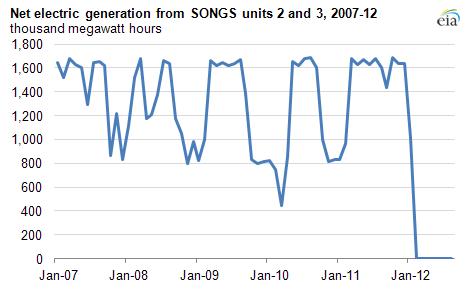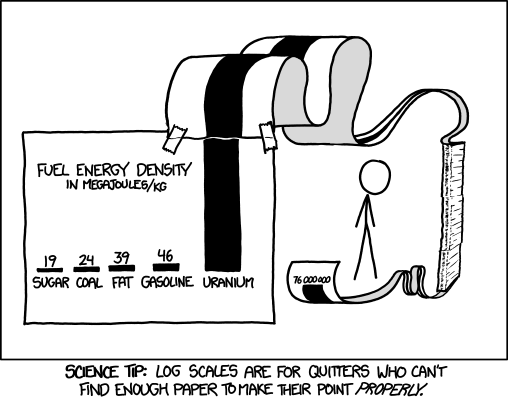Environment & Energy
Related: About this forumIn California, Nuclear Turns Off and Prices Go Up

"What would happen to electricity prices in the event of a significant nuclear power plant shutdown? If recent events in Southern California are any measure, electricity prices would go up.
In January of 2012, both reactors at San Onofre in Southern California were taken out of service. The result? Electricity prices in the north and south of the state are no longer comparable. Prices were up 12% in 2012 in “the Southland” compared to Northern California where PG&E’s Diablo Canyon keeps humming along, according to new data from the US Energy Information Administration.
Electric Light & Power magazine says that the difference is one of simple substitution. Switching off nuclear power has led to more expensive alternatives."
http://neinuclearnotes.blogspot.com/2013/04/in-california-nuclear-turns-off-and.html
greenman3610
(3,947 posts)If a unit of distributed electric generation, say a wind turbine, or a solar panel, has a problem, you can shut it down and replace it without pulling a huge amount of power off the grid. You certainly wouldn’t have to evacuate a city, or raise anyone’s prices.
Of course, WindBaggers like to say that renewable energy is “intermittent” – as if EVERY form of energy wasn’t intermittent. Nothing operates 100 percent – the question is, do you have a system that is cumbersome, expensive, and brittle, or resilient and forgiving when something goes wrong
(see below for what the sudden interruption of huge San Onofre (SONGS) power plant looks like)

wtmusic
(39,166 posts)and electricity bought on spot prices is more expensive. The dips are for regularly scheduled maintenance and refueling.
Calling a station that shuts down once in thirty years "intermittent" is a bit of a stretch, don't you think?
greenman3610
(3,947 posts)thousands of wind turbines spread over a large area, where you would statistically be
able to plan for a certain level of production, and predict when you might need
to back it up.
Unlike this nuke which drives off a cliff, renewables have more gentle and predictable
variations, which is why they have been so successful in places like northern Germany,
where they produce up to 50 percent and more power in some states, with
no backup other than load balancing in the grid.
wtmusic
(39,166 posts)
That's California today (blue line is wind) and each one of those bumps, were it not smoothed by the independent system operator with large amounts of CCGT, would take the entire system down. It takes lots of carbon to accommodate your "carbon-free" turbines.
Nuclear is not displayed because it would look very much like the grey line of geothermal for periods of 3-5 years straight.
FBaggins
(26,727 posts)And you absolutely can not "plan for a certain level of production".
renewables have more gentle and predictable variations
If by that you mean that individual units don't produce much, so their individual loss is "gentle"... and that you can predict that they will vary (as opposed to predicting the actual variations in advance)... then you would be correct. But I don't think that's what you meant.
which is why they have been so successful in places like northern Germany, where they produce up to 50 percent and more power in some states, with no backup other than load balancing in the grid.
There really isn't much correct there beyond the spelling. They do not produce 50% and more of their power with solar, except for very short periods... and they certainly don't do it without backup.
gcomeau
(5,764 posts)"Intermittent sources like nuclear"? That statement made in favor of WIND?
You understand that there is a monumental difference between a plant going down for maintenance once every few decades and hoping every day that you happen to get a good breeze? I'm all for wind as a supplemental energy source but grow up and deal with reality.

greenman3610
(3,947 posts)actually, nukes have to be refueled every 3 years or so, when they are down for 36 days or so.
So you have to have enormous back up if you build one right off the bat. Backup that you only
need once in a while, so is very costly to maintain - ratepayers are charged for that.
Of course, the California nuke in question closed because those pesky liberals
enforced "safety" standards because of some teeny weeny radiation leak.
What you're going to see is that, as wind development gains more steam, and as grids get
upgraded, which we have to do anyway, better interconnectedness will make up for
variability. In addition, during the months when in many areas, wind is the lightest, the
dog days of summer - solar will be coming more into play as a supplement.
so to die-hard warriors of big centralized energy, I say,
Chill out. We got this.
wtmusic
(39,166 posts)and you have no idea what you're talking about.
FBaggins
(26,727 posts)All grids have seasonal fluctuations in demand and have to have backup in excess of their largest generation station.
Normal refeuling/maintenance at large plants (coal/gas/hydro/nuclear) doesn't come as a surprise. They plan for it in advance to take place when demand is lower and/or other plants our out of maintenance cycles. It isn't "backup you need only once in awhile"
What you're going to see is that, as wind development gains more steam, and as grids get upgraded, which we have to do anyway, better interconnectedness will make up for variability.
Never... because it isn't true. Not without substantial storage.
In addition, during the months when in many areas, wind is the lightest, the dog days of summer - solar will be coming more into play as a supplement.
To which the obvious reply is that even during the summer, solar doesn't operate for enough of the day.
OKIsItJustMe
(19,938 posts)IF the SONGS closure caused prices to increase:
- Why did the price go down for 3 or 4 months following the closure?
- There seems to have been a similar price increase from April of 2009 through January of 2010. Was SONGS closed then too?
- Although prices have increased, they are not as high as they were in January of 2010.

Am I missing something here? Do these price fluctuations have anything to do with the SONGS closure?
wtmusic
(39,166 posts)from which CA gets half of its power.
OKIsItJustMe
(19,938 posts)The longer-term increase doesn’t seem to be much different than the earlier one, if anything it looks to be a little bit less.
wtmusic
(39,166 posts)gcomeau
(5,764 posts)...it's the seperation between the orange and blue lines.
SONGS supplies power to Southern California (Orange). Note how before it was closed Southern and Northern (Blue) had equivalent energy prices, after it closed southern got noticeably and consistently more expensive than northern.
OKIsItJustMe
(19,938 posts)I understood the “Bay Area” economy is recovering faster than the rest of the state:
http://www.huffingtonpost.com/2013/03/29/bay-area-job-market_n_2982101.html
gcomeau
(5,764 posts)OKIsItJustMe
(19,938 posts)(I am geographically challenged when it comes to California.)
However the situation seems to be more complicated than is suggested by the OP.
http://www.elp.com/articles/2013/03/san-onofre-nuclear-outage-destabilizing-energy-prices-in-califor.html
03/26/2013
[font size=3]…
Thus, higher wholesale power prices in Southern California more likely are attributable to the need for more-expensive generation in that region to fill the shortage. To ensure electric reliability in the densely populated Los Angeles and San Diego regions, Southern California needs to use local generation sources and cannot solely rely on imported electricity to replace generation from SONGS. The major nearby alternative sources, however, are more expensive, and seem to be contributing to higher wholesale power prices.
In 2012, the continuing SONGS closure put pressure on the electric power grid operator, the California Independent System Operator (CAISO), to adjust both generation and transmission in order to meet summer demand for electricity, and in general, continues to change the generation profile in the area.
In a recent filing with the Federal Energy Regulatory Commission (FERC), CAISO requested changes to a transmission constraint rule in an attempt to resolve transmission congestion that is contributing to higher prices. The proposed change would reduce the price point at which CAISO relaxes a transmission operating limit and allows more electricity to flow.
Southern California Edison released an operational assessment on March 14 for restarting SONGS unit 2; the restart requires the approval of the Nuclear Regulatory Commission (NRC). The NRC is holding public meetings and conducting a technical evaluation of restarting this unit and has tentatively scheduled a decision for some time after May 2013.[/font][/font]